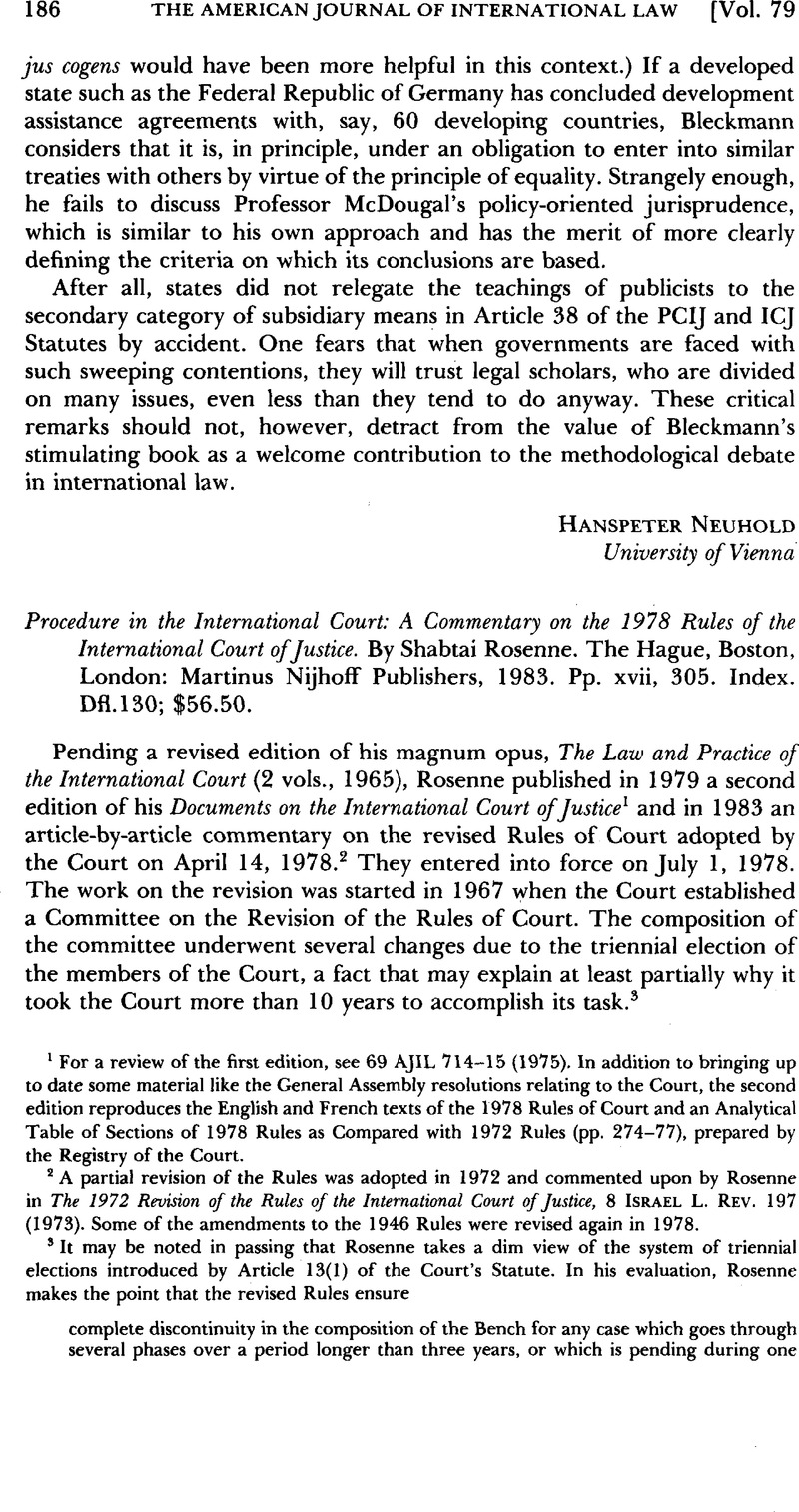No CrossRef data available.
Article contents
Procedure in the International Court: A Commentary on the 1978 Rules of the International Court of Justice. By Shabtai Rosenne. The Hague, Boston, London: Martinus Nijhoff Publishers, 1983. Pp. xvii, 305. Index. Dfl.130; $56.50.
Published online by Cambridge University Press: 23 March 2017
Abstract

- Type
- Book Reviews and Notes
- Information
- Copyright
- Copyright © American Society of International Law 1985
References
1 For a review of the first edition, see 69 AJIL 714–15 (1975). In addition to bringing up to date some material like the General Assembly resolutions relating to the Court, the second edition reproduces the English and French texts of the 1978 Rules of Court and an Analytical Table of Sections of 1978 Rules as Compared with 1972 Rules (pp. 274–77), prepared by the Registry of the Court.
2 A partial revision of the Rules was adopted in 1972 and commented upon by Rosenne, in The 1972 Revision of the Rules of the International Court of Justice, 8 Israel L. Rev. 197 (1973)Google Scholar. Some of the amendments to the 1946 Rules were revised again in 1978.
3 It may be noted in passing that Rosenne takes a dim view of the system of triennial elections introduced by Article 13(1) of the Court’s Statute. In his evaluation, Rosenne makes the point that the revised Rules ensure
complete discontinuity in the composition of the Bench for any case which goes through several phases over a period longer than three years, or which is pending during one of the triennial elections, save in very exceptional circumstances. Many observers of the work of the Court have pinpointed the uncertainty which this engenders as regards the composition of the Bench as one of the major factors detracting from the appeal of the Court as an organ for the settlement of international disputes [p. 241].
4 For stimulating some of the 1978 revisions, credit is given to the Heidelberg Symposium of 1972, the Panel of the American Society of International Law on the Future of the ICJ (p. 3 n.16) and discussions in the United Nations in 1970–1974 on the Court. The results of the Heidelberg Symposium appeared in Judicial Settlement of International Disputes (Mosler, H. & Bernhardt, R. eds. 1974)Google Scholar and the results of the work of the panel appeared in The Future of the International Court of Justice (Gross, L. ed., 2 vols., 1976)Google Scholar. Rosenne was an active participant in both the symposium and the panel.
5 Paragraph 1 of Article 290, as finally adopted, provides that the tribunal or court shall have the power to “prescribe” provisional measures, and paragraph 6 provides: “The parties to the dispute shall comply promptly with any provisional measures prescribed under this article.”
6 Attention may be drawn to paragraph 6 of Article 79 of the new Rules, which was introduced in 1972: “In order to enable the Court to determine its jurisdiction at the preliminary stage of the proceedings, the Court, whenever necessary, may request the parties to argue all questions of law and fact, and to adduce all evidence, which bear on the issue” (p. 158). See Rosenne’s comment (pp. 162–64), particularly on the difficulty of disposing of objections to jurisdiction ratione temporis without a thorough airing of the merits (p. 163). While admitting all the difficulties, it would seem that paragraph 6 of Article 79 puts into the hands of the Court a tool for coping with dilatory tactics of the parties. It was, after all, one of the objectives of the revision to enable the Court to assume a more active role in the proceedings.


